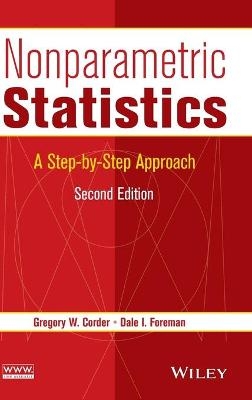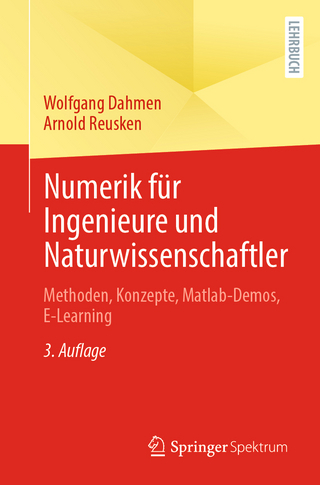
Nonparametric Statistics
John Wiley & Sons Inc (Verlag)
978-1-118-84031-3 (ISBN)
“…a very useful resource for courses in nonparametric statistics in which the emphasis is on applications rather than on theory. It also deserves a place in libraries of all institutions where introductory statistics courses are taught." –CHOICE
This Second Edition presents a practical and understandable approach that enhances and expands the statistical toolset for readers. This book includes:
New coverage of the sign test and the Kolmogorov-Smirnov two-sample test in an effort to offer a logical and natural progression to statistical power
SPSS® (Version 21) software and updated screen captures to demonstrate how to perform and recognize the steps in the various procedures
Data sets and odd-numbered solutions provided in an appendix, and tables of critical values
Supplementary material to aid in reader comprehension, which includes: narrated videos and screen animations with step-by-step instructions on how to follow the tests using SPSS; online decision trees to help users determine the needed type of statistical test; and additional solutions not found within the book.
Greg W. Corder is Adjunct Instructor in the Department of Physics and Astronomy at James Madison University. He is also Adjunct Instructor of graduate education at Mary Baldwin College. Dale I. Foreman is Professor Emeritus in the School of Education and Human Development at Shenandoah University.
Preface ix
List of Variables xiii
Chapter 1 Nonparametric Statistics: An Introduction 1
1.1 Objectives 1
1.2 Introduction 1
1.3 The Nonparametric Statistical Procedures Presented in This Book 3
1.3.1 State the Null and Research Hypotheses 4
1.3.2 Set the Level of Risk (or the Level of Significance) Associated with the Null Hypothesis 4
1.3.3 Choose the Appropriate Test Statistic 5
1.3.4 Compute the Test Statistic 5
1.3.5 Determine the Value Needed for Rejection of the Null Hypothesis Using the Appropriate Table of Critical Values for the Particular Statistic 5
1.3.6 Compare the Obtained Value with the Critical Value 6
1.3.7 Interpret the Results 6
1.3.8 Reporting the Results 6
1.4 Ranking Data 6
1.5 Ranking Data with Tied Values 7
1.6 Counts of Observations 8
1.7 Summary 9
1.8 Practice Questions 9
1.9 Solutions to Practice Questions 10
Chapter 2 Testing Data for Normality 13
2.1 Objectives 13
2.2 Introduction 13
2.3 Describing Data and the Normal Distribution 14
2.4 Computing and Testing Kurtosis and Skewness for Sample Normality 17
2.4.1 Sample Problem for Examining Kurtosis 19
2.4.2 Sample Problem for Examining Skewness 22
2.4.3 Examining Skewness and Kurtosis for Normality Using SPSS 24
2.5 Computing the Kolmogorov–Smirnov One-Sample Test 27
2.5.1 Sample Kolmogorov–Smirnov One-Sample Test 29
2.5.2 Performing the Kolmogorov–Smirnov One-Sample Test Using SPSS 34
2.6 Summary 37
2.7 Practice Questions 37
2.8 Solutions to Practice Questions 38
Chapter 3 Comparing Two Related Samples: The Wilcoxon Signed Rank and the Sign Test 39
3.1 Objectives 39
3.2 Introduction 39
3.3 Computing the Wilcoxon Signed Rank Test Statistic 40
3.3.1 Sample Wilcoxon Signed Rank Test (Small Data Samples) 41
3.3.2 Confidence Interval for the Wilcoxon Signed Rank Test 43
3.3.3 Sample Wilcoxon Signed Rank Test (Large Data Samples) 45
3.4 Computing the Sign Test 49
3.4.1 Sample Sign Test (Small Data Samples) 50
3.4.2 Sample Sign Test (Large Data Samples) 53
3.5 Performing the Wilcoxon Signed Rank Test and the Sign Test Using SPSS 57
3.5.1 Define Your Variables 57
3.5.2 Type in Your Values 57
3.5.3 Analyze Your Data 58
3.5.4 Interpret the Results from the SPSS Output Window 58
3.6 Statistical Power 60
3.7 Examples from the Literature 61
3.8 Summary 61
3.9 Practice Questions 62
3.10 Solutions to Practice Questions 65
Chapter 4 Comparing Two Unrelated Samples: The Mann−Whitney U-Test and the Kolmogorov−Smirnov Two-Sample Test 69
4.1 Objectives 69
4.2 Introduction 69
4.3 Computing the Mann−Whitney U-Test Statistic 70
4.3.1 Sample Mann−Whitney U-Test (Small Data Samples) 71
4.3.2 Confidence Interval for the Difference between Two Location Parameters 74
4.3.3 Sample Mann−Whitney U-Test (Large Data Samples) 75
4.4 Computing the Kolmogorov–Smirnov Two-Sample Test Statistic 80
4.4.1 Sample Kolmogorov–Smirnov Two-Sample Test 81
4.5 Performing the Mann–Whitney U-Test and the Kolmogorov–Smirnov Two-Sample Test Using SPSS 84
4.5.1 Define Your Variables 84
4.5.2 Type in Your Values 85
4.5.3 Analyze Your Data 86
4.5.4 Interpret the Results from the SPSS Output Window 86
4.6 Examples from the Literature 88
4.7 Summary 89
4.8 Practice Questions 90
4.9 Solutions to Practice Questions 92
Chapter 5 Comparing More Than Two Related Samples: The Friedman Test 97
5.1 Objectives 97
5.2 Introduction 97
5.3 Computing the Friedman Test Statistic 98
5.3.1 Sample Friedman’s Test (Small Data Samples without Ties) 99
5.3.2 Sample Friedman’s Test (Small Data Samples with Ties) 101
5.3.3 Performing the Friedman Test Using SPSS 105
5.3.4 Sample Friedman’s Test (Large Data Samples without Ties) 108
5.4 Examples from the Literature 111
5.5 Summary 112
5.6 Practice Questions 113
5.7 Solutions to Practice Questions 114
Chapter 6 Comparing More Than Two Unrelated Samples: The Kruskal–Wallis H-Test 117
6.1 Objectives 117
6.2 Introduction 117
6.3 Computing the Kruskal–Wallis H-Test Statistic 118
6.3.1 Sample Kruskal–Wallis H-Test (Small Data Samples) 119
6.3.2 Performing the Kruskal–Wallis H-Test Using SPSS 124
6.3.3 Sample Kruskal–Wallis H-Test (Large Data Samples) 128
6.4 Examples from the Literature 134
6.5 Summary 134
6.6 Practice Questions 135
6.7 Solutions to Practice Questions 136
Chapter 7 Comparing Variables of Ordinal or Dichotomous Scales: Spearman Rank Order, Point-Biserial, and Biserial Correlations 139
7.1 Objectives 139
7.2 Introduction 139
7.3 The Correlation Coefficient 140
7.4 Computing the Spearman Rank-Order Correlation Coefficient 140
7.4.1 Sample Spearman Rank-Order Correlation (Small Data Samples without Ties) 142
7.4.2 Sample Spearman Rank-Order Correlation (Small Data Samples with Ties) 145
7.4.3 Performing the Spearman Rank-Order Correlation Using SPSS 148
7.5 Computing the Point-Biserial and Biserial Correlation Coefficients 150
7.5.1 Correlation of a Dichotomous Variable and an Interval Scale Variable 150
7.5.2 Correlation of a Dichotomous Variable and a Rank-Order Variable 152
7.5.3 Sample Point-Biserial Correlation (Small Data Samples) 152
7.5.4 Performing the Point-Biserial Correlation Using SPSS 156
7.5.5 Sample Point-Biserial Correlation (Large Data Samples) 159
7.5.6 Sample Biserial Correlation (Small Data Samples) 163
7.5.7 Performing the Biserial Correlation Using SPSS 167
7.6 Examples from the Literature 167
7.7 Summary 167
7.8 Practice Questions 168
7.9 Solutions to Practice Questions 170
Chapter 8 Tests for Nominal Scale Data: Chi-Square and Fisher Exact Tests 172
8.1 Objectives 172
8.2 Introduction 172
8.3 The χ2 Goodness-of-Fit Test 172
8.3.1 Computing the χ2 Goodness-of-Fit Test Statistic 173
8.3.2 Sample χ2 Goodness-of-Fit Test (Category Frequencies Equal) 173
8.3.3 Sample χ2 Goodness-of-Fit Test (Category Frequencies Not Equal) 176
8.3.4 Performing the χ2 Goodness-of-Fit Test Using SPSS 180
8.4 The χ2 Test for Independence 184
8.4.1 Computing the χ2 Test for Independence 185
8.4.2 Sample χ2 Test for Independence 186
8.4.3 Performing the χ2 Test for Independence Using SPSS 190
8.5 The Fisher Exact Test 196
8.5.1 Computing the Fisher Exact Test for 2 × 2 Tables 197
8.5.2 Sample Fisher Exact Test 197
8.5.3 Performing the Fisher Exact Test Using SPSS 201
8.6 Examples from the Literature 202
8.7 Summary 203
8.8 Practice Questions 204
8.9 Solutions to Practice Questions 206
Chapter 9 Test for Randomness: The Runs Test 210
9.1 Objectives 210
9.2 Introduction 210
9.3 The Runs Test for Randomness 210
9.3.1 Sample Runs Test (Small Data Samples) 212
9.3.2 Performing the Runs Test Using SPSS 213
9.3.3 Sample Runs Test (Large Data Samples) 217
9.3.4 Sample Runs Test Referencing a Custom Value 219
9.3.5 Performing the Runs Test for a Custom Value Using SPSS 221
9.4 Examples from the Literature 225
9.5 Summary 225
9.6 Practice Questions 225
9.7 Solutions to Practice Questions 227
Appendix A SPSS at a Glance 229
Appendix B Critical Value Tables 235
References 261
Index 265
| Verlagsort | New York |
|---|---|
| Sprache | englisch |
| Maße | 158 x 236 mm |
| Gewicht | 612 g |
| Themenwelt | Geisteswissenschaften ► Psychologie |
| Mathematik / Informatik ► Mathematik ► Analysis | |
| Mathematik / Informatik ► Mathematik ► Statistik | |
| Mathematik / Informatik ► Mathematik ► Wahrscheinlichkeit / Kombinatorik | |
| Sozialwissenschaften ► Soziologie | |
| ISBN-10 | 1-118-84031-3 / 1118840313 |
| ISBN-13 | 978-1-118-84031-3 / 9781118840313 |
| Zustand | Neuware |
| Haben Sie eine Frage zum Produkt? |
aus dem Bereich


